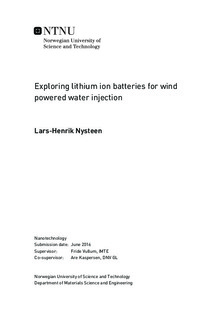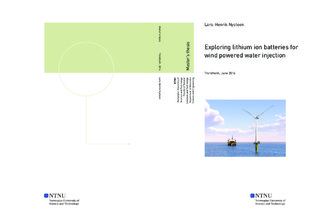| dc.description.abstract | In this work, lithium ion batteries consisting of carbon-coated silica (\ce{SiO2}) anodes and various commercial cathodes were prepared, tested, and analysed for use in a novel wind-powered water injection system, designed by DNV GL. The carbon-coated anodes were fabricated using abundant, sea-hauled diatoms, a type of unicellular algae, as the \ce{SiO2}-containing precursor. The as-recieved diatoms were cleaned, wet-mixed with a carbon-containing precursor, before heat treatment in a flowing Ar atmosphere. The obtained carbon-coated SiO$_2$ active material was characterized using field-emission scanning electron microscopy, x-ray diffraction, thermogravimetric analysis, and nitrogen adsorption measurements.
Anode electrode sheets were fabricated by mixing the carbon-coated SiO$_2$ active material with an aqueous sodium alginate binder and carbon black conductive filler to form a homogeneous, viscous slurry, which was tape casted onto copper foil. The cathode electrode sheets were prepared in a similar fashion, but using commercial \ce{LiMn2O4}, \ce{Li(Ni$_{1/3}$Mn$_{1/3}$Co$_{1/3}$)O2} and carbon-coated \ce{LiFePO4} cathode active material, polyvinylidene fluoride binder and carbon black to form the slurry, and casted on aluminium foil.
The prepared anode and cathode electrodes were then assembled into coin cells with lithium counter electrodes and subjected to galvanostatic charge-discharge testing to evaluate the cycling stability and rate capability of the individual materials. High reversible specific capacities, above 460\si{\milli\ampere\hour\per\gram} at a current density of 50\si{\milli\ampere\per\gram}, and excellent rate capability was achieved for the carbon-coated \ce{SiO2} anodes, attributed to improved electrical conductivity of the carbon coating, the high surface area and porosity of the diatom precursor and the formation of a stabilizing inert matrix of \ce{Li2O} and \ce{Li4SiO4}. The commercial cathodes, with the exception of \ce{LiFePO4}, showed acceptable reversible capacities, and fair rate performance.
Next, the optimized anode material was used as an anode in a full lithium ion battery cell, investigated here for the first time. Poor initial Coulombic efficiency was identified as the largest performance-limiting factor of the assembled full cells. Several approaches to improve the reversible capacity were explored, including formation cycling, prelithiation of the SiO$_2$ anode, and decreasing the lower cell voltage cut-off potential. The full cells containing a prelithiated anode and discharged to low cell voltages showed the highest reversible capacity, but significant capacity fading due to possible anode material degradation following the deep discharge was observed. The rate performance of the full cells was found to be better or similar to that of the half cells, but the same capacity fading was noted.
The energy density of the cells fabricated in this work was found to be comparable to commercial cells containing lithium titanate (\ce{Li4Ti5O12}) anodes, even with the sub-optimal cathodes used. Based on the energy and power density achieved in the full cell testing for the \ce{SiO2} anode, and the assumption that the anode shows stable cycling over thousands of cycles in combination with an optimized commercial \ce{LiFePO4} cathode, the \ce{SiO2}-based batteries was found to be a potential candidate for use as an energy storage system in a wind-powered water injection system, showing a higher energy density than \ce{Li4Ti5O12}-based chemistries, as well as lower cost per cell. | |

